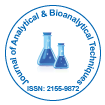The Role of Alkyl Groups in Organic Chemistry and Drug Design
Received: 01-Feb-2025 / Manuscript No. jabt-25-163314 / Editor assigned: 04-Feb-2025 / PreQC No. jabt-25-163314 (PQ) / Reviewed: 18-Feb-2025 / QC No. jabt-25-163314 / Revised: 22-Feb-2025 / Manuscript No. jabt-25-163314 (R) / Published Date: 27-Feb-2025 DOI: 10.4172/2155-9872.1000735
Abstract
Alkyl groups play a crucial role in organic chemistry and drug design due to their ability to influence molecular stability, reactivity, and biological interactions. These hydrophobic moieties impact pharmacokinetics, drug solubility, and receptor binding, making them fundamental in medicinal chemistry. Their applications extend to structural modifications of bioactive molecules, enhancing drug efficacy and specificity. This article explores the chemical properties of alkyl groups, their role in organic synthesis, and their significance in drug development. Additionally, it discusses recent advancements in alkyl-based drug design and the challenges associated with alkyl modifications.
Keywords
Alkyl groups; Organic chemistry; Drug design; Pharmacokinetics; Hydrophobicity; Bioavailability; Alkylation reactions; Lipophilicity; Medicinal chemistry; Structural modification
Introduction
Alkyl groups are fundamental components in organic chemistry and pharmaceutical sciences. These groups, composed of carbon and hydrogen atoms arranged in linear, branched, or cyclic forms, influence the physical and chemical properties of organic compounds. The incorporation of alkyl groups in drug molecules can significantly impact their solubility, stability, and interaction with biological targets. Due to their hydrophobic nature, alkyl groups often enhance membrane permeability, improving drug absorption and distribution. This article explores the role of alkyl groups in organic reactions, their effect on molecular behavior, and their applications in drug design [1-3].
Description
Structure and classification of alkyl groups
Alkyl groups are derived from alkanes by the removal of a hydrogen atom. They are classified into different types based on their structure:
Primary alkyl groups: A single carbon attached to a functional group (e.g., methyl, ethyl).
Secondary alkyl groups: A carbon bonded to two other carbons (e.g., isopropyl).
Tertiary alkyl groups: A central carbon bonded to three other carbons (e.g., tert-butyl).
Cyclic alkyl groups: Carbon atoms arranged in ring structures (e.g., cyclohexyl).
Chemical properties of alkyl groups
Hydrophobicity: Alkyl groups increase the nonpolar character of molecules, affecting solubility in organic solvents [4,5].
Steric effects: Bulky alkyl groups can hinder or enhance reactions by influencing spatial arrangements.
Electron-donating effects: Alkyl groups donate electron density through hyperconjugation, stabilizing carbocations in reaction mechanisms.
Role of alkyl groups in drug design
Influence on drug properties
Alkyl groups impact various pharmacological properties of drugs, including:
Lipophilicity: Enhanced lipophilicity allows drugs to cross lipid membranes more efficiently, increasing bioavailability [6].
Metabolic stability: Alkyl groups can shield drugs from enzymatic degradation, prolonging their half-life.
Binding affinity: Modulating alkyl group placement can optimize drug-target interactions, improving efficacy.
Alkylation in medicinal chemistry
Alkylation reactions are widely used in drug synthesis to modify bioactive compounds. Examples include:
Alkylating agents in chemotherapy: Drugs like cyclophosphamide utilize alkylation to disrupt DNA in cancer cells [7].
Prodrug activation: Alkyl modifications help create prodrugs that are metabolically activated in the body.
Structural optimization: Alkylation enhances drug-receptor binding by modifying steric and electronic effects [8-10].
Discussion
Applications of Alkyl Groups in Pharmaceuticals
Antibiotics: Alkyl modifications improve antibacterial activity and stability (e.g., macrolides, fluoroquinolones).
Analgesics: Structural tuning with alkyl groups enhances potency and selectivity (e.g., opioids, NSAIDs).
Antidepressants: Lipophilic alkyl groups in SSRIs improve blood-brain barrier penetration.
Challenges in alkyl-based drug design
Toxicity issues: Highly lipophilic drugs may accumulate in fat tissues, leading to adverse effects.
Metabolic breakdown: Some alkyl groups render drugs more susceptible to metabolic degradation.
Regulatory concerns: Alkyl-modified drugs must undergo stringent testing for safety and efficacy.
Conclusion
Alkyl groups play a vital role in organic chemistry and drug design by modulating physicochemical properties, optimizing pharmacokinetics, and improving therapeutic efficacy. While challenges such as toxicity and metabolic stability persist, advancements in computational chemistry and sustainable synthesis methods continue to refine alkyl-based drug design. Future research will further harness the potential of alkyl modifications in developing next-generation pharmaceuticals.
Acknowledgement
None
Conflict of Interest
None
References
- Sethi PD (2006) High Performance Liquid Chromatography Quantitative Analysis of Pharmaceutical Formulations 4th Edn 11-97.
- Skoog DA, Holler FJ, Crouch SR (2017) Principles of instrumental analysis 6th ed. Delhi Cengage learning 806-835.
- (2005) Validation of analytical procedures: Text and Methodology Q2 (R1). ICH Harmonized Tripartite Guideline 4-13.
- Lambert S, Valiulis Q (2018) Cheng Advances in optical sensing and bioanalysis enabled by 3D printing. ACS Sens 3: 2475-2491.
- Kim E, Kim J, Choi I, Lee J, Yeo WS, et al. (2020) Organic matrix-free imaging mass spectrometry. BMB reports 53:349.
- Wang Y, Han Y, Hu W, Fu D, Wang G (2020) Analytical strategies for chemical characterization of bio‐oil. Journal of separation science 43:360-371.
- Anselmo AC, Mitragotri S (2014) An overview of clinical and commercial impact of drug delivery systems. J Control Release 190: 1528.
- Abdelgadir E (2012) Exploring Barriers to the Utilization of Mental Health Services at the Policy and Facility Levels in Khartoum State Sudan. University of Washington.
- Abbo C (2011) Profiles and outcome of traditional healing practices for severe mental illnesses in two districts of Eastern Uganda. Global health action 4:7117.
- Chatwal GR, Anand SK (2002) Instrumental methods of chemical analysis 5th edition. Mumbai Himalaya publishing house 2149-2184.
Indexed at, Google Scholar, Crossref
Indexed at, Google Scholar, Crossref
Indexed at, Google Scholar, Crossref
Indexed at, Google Scholar, Crossref
Indexed at, Google Scholar, Crossref
Citation: Bailey N (2025) The Role of Alkyl Groups in Organic Chemistry and Drug Design. J Anal Bioanal Tech 16: 735. DOI: 10.4172/2155-9872.1000735
Copyright: © 2025 Bailey N. This is an open-access article distributed under the terms of the Creative Commons Attribution License, which permits unrestricted use, distribution, and reproduction in any medium, provided the original author and source are credited.
Select your language of interest to view the total content in your interested language
Share This Article
Open Access Journals
Article Tools
Article Usage
- Total views: 3545
- [From(publication date): 0-0 - Dec 07, 2025]
- Breakdown by view type
- HTML page views: 3358
- PDF downloads: 187
